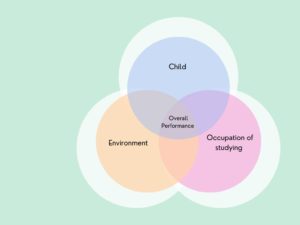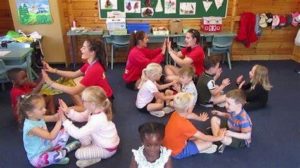Primitive reflexes are automatic movements that are necessary for an infant’s survival. They are also crucial for developing higher motor functions. Primitive reflexes are typically integrated a year after birth. But in some instances, they can be retained. And when primitive reflexes are retained, they can cause difficulties in different aspects of a child’s life.
For this blog, we will focus on the effects that retained primitive reflexes have on a child’s education and social well-being and how we can make minor adjustments in the child’s environment to aid them through the difficulties they may face.
Children who have retained primitive reflexes expend their energy just trying to control the effects of these reflexes, which can affect their learning. They can also affect a child’s social functioning as the result of certain primitive reflexes, are anxiety and emotional dysregulation. Now, let’s dig a little deeper into these reflexes, what they are, and how exactly they can affect the educational and social aspects of a child’s life.
Asymmetrical Tonic Neck Reflex (ATNR) is a reflex that is present at birth and integrates around 3 to 9 months. This reflex helps in developing higher motor skills like midline crossing, cross-pattern movements, and hand-eye coordination. It also helps children in developing muscle tone. If this reflex is retained, then children can have difficulties in visual tracking, crossing their visual midline, and poor eye-hand coordination. Most tasks in the classroom require visual tracking and the ability to cross the visual midline. Both reading and writing need us to cross our visual midline. So when children have trouble with this, they have difficulties with these tasks, and this can mimic symptoms of a learning disorder like dyslexia when it could be the result of retained primitive reflexes.
The following primitive reflex we are looking at is the Symmetrical Tonic Neck Reflex (STNR). This occurs at the 6-9 months stage and is integrated by 9-11 months. This reflex prepares the child for crawling and helps in head control. When this primitive reflex is retained, children have trouble with postural control and attention. A school setting requires a child to have good posture. And this is so that the body is in good alignment and the stress on the muscles and joints is evenly distributed so that children do not get fatigued quickly. Good posture also helps with the ability to pay attention. Another symptom of retained STNR is difficulty in focusing. Most activities in a school setting require a child to pay attention and be focused on meeting the demands of the school tasks. Therefore this, combined with the effects of poor posture, can make it difficult for the child to stay focused in a classroom, thus affecting their ability to learn.
Tonic Labyrinthine Reflex (TLR) is another reflex that is present at birth and disappears around 4 to 6 months after birth. If it is retained, it can affect auditory discrimination. It can also bring about difficulties in re-establishing emotional balance and controlling eye movements. When children have issues with controlling eye movements, it is difficult to copy and write sentences written on the board, and they can also face difficulties with reading. Its effects on auditory discrimination can also make it difficult to follow instructions.
Spinal Galant Reflex (SGR) is a primitive reflex that integrates around six months after birth. The symptoms of retained SGR are restlessness and difficulties with short-term memory. In the classroom, children with retained SGR will have trouble concentrating while a teacher is taking the class and also with completing work independently. Its effects on short-term memory can make it hard to follow instructions and directions.
Moro reflex, or the startle reflex, is present at birth and integrates around 4-6 months after birth. This startle reflex elicits the flight or fight response in the infant. If this reflex is retained, then children will have an exaggerated startle reflex. Thus increasing the threshold for a child’s stress levels, therefore, contributing to increased anxiety. This can affect how children interact with their peers, making it difficult to interact. This retained primitive reflex can also make children more sensitive to incoming sensory information. Therefore it can lead to sensory overload. Especially in a school setting, the child is exposed to noisy environments like a break room or playground.
Lastly, we have the Palmar reflex. It is present at birth and is integrated at about six months of age. The palmar reflex is the precursor for actively grabbing and holding objects. When this reflex is not integrated, children will have difficulties with fine motor movements. In a school setting, where kids are required to write, children with retained palmar reflex will have poor pencil grasp, thus making it harder to write. Other fine motor skills like tying a shoelace and typing will also be something that children struggle with.
Now that we understand how retained primitive reflexes can affect learning and what it can look like in a classroom setting let’s move on to ways we can adapt and change the learning environment to accommodate children with retained primitive reflexes.
 A child’s overall performance depends on three components; The child, the environment, and the occupation of studying. If there are any issues in any of these three components, it can affect the child’s academic performance. Therefore, when we make modifications to each of these components, it can lead to an increase in overall performance. Let’s look at what some of these modifications can be.
A child’s overall performance depends on three components; The child, the environment, and the occupation of studying. If there are any issues in any of these three components, it can affect the child’s academic performance. Therefore, when we make modifications to each of these components, it can lead to an increase in overall performance. Let’s look at what some of these modifications can be.
Interventions/modifications for the child
- Therapy: Several therapies directly work on integrating retained primitive reflexes. Some of them include Masgutova Neurosensorimotor Reflex Integration (MNRI), Rhythmic Movement Therapy (RMT), Movement based learning (MBL), Occupational Therapy (OT), Physical Therapy, and brain gym.
 Sensory breaks: One of the symptoms of retained primitive reflexes is a sensitive sensory system. Keeping children on a sensory diet can help them better regulate their nervous system. Therefore increasing attention and arousal during classes. An example of a sensory diet can be that for every class that the child sits on a chair, they get some time on a bean bag before moving to the next class. Another example could be the child being given 2 minutes of music/white noise every half hour. Using fidget toys and stress balls can also be given as a sensory break. The sensory diet can vary depending on the child’s needs.
Sensory breaks: One of the symptoms of retained primitive reflexes is a sensitive sensory system. Keeping children on a sensory diet can help them better regulate their nervous system. Therefore increasing attention and arousal during classes. An example of a sensory diet can be that for every class that the child sits on a chair, they get some time on a bean bag before moving to the next class. Another example could be the child being given 2 minutes of music/white noise every half hour. Using fidget toys and stress balls can also be given as a sensory break. The sensory diet can vary depending on the child’s needs. Movement breaks: Children can be given different movement breaks throughout the day. They help children improve their posture, balance, coordination, and muscle strength. Examples of movement breaks include jumping on the trampoline and different animal walks. It can even be as simple as dancing to a song or playing a clapping game.
Movement breaks: Children can be given different movement breaks throughout the day. They help children improve their posture, balance, coordination, and muscle strength. Examples of movement breaks include jumping on the trampoline and different animal walks. It can even be as simple as dancing to a song or playing a clapping game.
Modifications to the environment
 Different seating options: Changing the child’s seating arrangement depending on their needs is one way to modify the environment to facilitate learning better. Providing chairs with back support and using appropriately sized chairs and tables will help children maintain proper posture, increasing attention and focus. Stability balls can also be used to improve balance and posture. Ensuring that the child is sitting close enough to the board, if the child is hyperactive, then seating them next to a calmer child are some variables that can be easily modified and positively impact attention.
Different seating options: Changing the child’s seating arrangement depending on their needs is one way to modify the environment to facilitate learning better. Providing chairs with back support and using appropriately sized chairs and tables will help children maintain proper posture, increasing attention and focus. Stability balls can also be used to improve balance and posture. Ensuring that the child is sitting close enough to the board, if the child is hyperactive, then seating them next to a calmer child are some variables that can be easily modified and positively impact attention.- Lighting and ventilation: Some children with primitive reflexes have problems with visual processing. Thus, ensuring the environment is well-lit and adequate ventilation can accommodate the learning environment. Warm lighting that is not too bright, using diffusers, and keeping the noise level to a minimum can make the environment more calming for children with anxiety.
Modifications to occupation
 Visual aids: using as many visual aids as possible can help children with retained primitive reflexes better understand the concepts being taught. Teaching using diagrams, pictures, and videos helps them retain information in their memory without getting lost.
Visual aids: using as many visual aids as possible can help children with retained primitive reflexes better understand the concepts being taught. Teaching using diagrams, pictures, and videos helps them retain information in their memory without getting lost.- Simplified instructions: Breaking down tasks into smaller steps can help children better process the instructions given.
- Tool adaptations: If children have problems with fine motor movements like writing, using larger writing tools or notebooks with bigger lines can help improve their grip control, writing, and drawing skills.

If you found this blog useful, here are some more resources to help you.
1. https://www.playstreet.in/2023/04/02/impact-of-retained-primitive-reflexes-on-motor-development/
2. https://www.playstreet.in/2023/03/23/retained-primitive-reflexes/
References:
- Banks, Molly, “The Effects Of Retained Primitive Reflexes On Students’ Occupational And Academic Performance In The School Setting” (2022). Occupational Therapy Capstones. 497. https://commons.und.edu/ot-grad/497
- Melillo, R., Leisman, G., Machado, C., Machado-Ferrer, Y., Chinchilla-Acosta, M., Kamgang, S., Melillo, T., & Carmeli, E. (2022). Retained Primitive Reflexes and Potential for Intervention in Autistic Spectrum Disorders. Frontiers in neurology, 13, 922322. https://doi.org/10.3389/fneur.2022.922322
- Lecce, Jerilyn. (2018). Retained Primitive Moro reflex Effect on Development. https://www.intermountain.org/retained-primitive-moro-reflex-effect-on-development/#:~:text=A%20child%20with%20a%20retained,movements%2C%20decreased%20visual%20perception%20



0 Comments